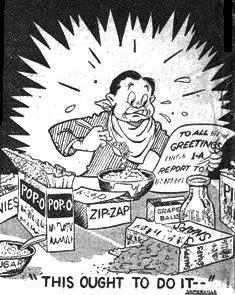
VOL. II NO. 31 REG NO. L5015 DELHI, THURSDAY APRIL 13, 1944
Japanese Give Ground In Grim Jungle Chess
 MARILYN MAXWELL
MARILYN MAXWELL
As if the introduction will do you any good |
NORTHERN BURMA - In the narrow upper neck of the Mogaung Valley, Lt. Gen. Joseph W. Stilwell's Chinese-American forces and the stubbornly-retreating Japanese continued this week to play their grim game of jungle chess.
The Japanese gave more ground, each inch bitterly surrendered, but today the Chinese had crushed the defenses of Wakawng, two miles north of Laban along the main Mogaung Valley road, and were hammering insistently upon the door of Warazup, three miles south of Wakawng along that bloody artery.
Meanwhile, a delayed report described a hit-and-run action above Kaimaing in which a unit of Merrill's Marauders waged eight bitter days of fighting in the mountains east of the Mogaung Valley before another Yank force battled its way through to relieve the situation. Air-dropped artillery helped the partially-encircled Yanks until the approach of the second column, which then proceeded to squeeze the northernmost Jap contingents into an all-American nutcracker.
CLOSE-IN FIGHTING
Fighting was often at such close range that Merrill's gunners fired through open sights, simply training their guns in the general direction of the enemy. Comparitively fresh troops, some described as "big men, well equipped," formed part of the Jap opposition. This action had the value of throwing a monkey wrench into the enemy's plan to maneuver behind the Chinese moving down the valley's main road.
Maj. Gen. Liao Yao-Hsiang's Chinese 22nd Division has been making the principal advance in the southward push against resistance verging upon suicidal. Against heavily-timbered prepared positions, the Allies are throwing tanks, artillery, infantry and planes and have advanced to an area west of Warazup, south of the Naungmu River.
Infantry gains in this sector were underlined by the heroic action of a Chinese soldier whose foot was blown off by a Jap grenade. He didn't falter. Hobbling forward, he bayonetted to death the Jap who lobbed the missile, was promptly recommended for a decoration.
East of the road, units of both the 22nd and 38th moved southward, mopping up the villages of Mihoigantawng, Marangahtawng, Wakawng and Tingring en route.
ARTILLERY DUELS
Artillery duels continue, and the harsh throats of the Jap 150's continue to belch shells at the Chinese-American advance toward Kamaing, now 20 miles away. Stilwell considered that the Leban-Shadazup noose last week might have trapped the "nervous nellies," but in the western portion of the valley a good Jap-built road, screened from aerial observation, was discovered over which the 150's were probably rescued.
It is obvious that the Japanese are stalling for precious time, and according to Stilwell, "doing a damn good job of it." The enemy's strategy is to delay Stilwell's forces long enough for the monsoon to bog down the Northern Burma offensive. The fierce rains are due to start in May, halting operations for four months, but old-time Burma residents contend a late monsoon is likely, in years such as the current one, in which there has been more than a normal rainfall during the winter and spring months.
However, after four months of hacking their way through the dense, constricting jungle, Stilwell's forces now have the worst terrain behind them and will now be able to fan out for the drive on Kamaing, and later, Mogaung and Myitkyina. Kamaing (peace-time population: 2,000) is on the plain, connected with Mogaung by water and road. Mogaung, 25 miles south, is the northern terminus of the Burma Railway.
The British-commanded Ghurka and Kachin forces have crossed the Tiang River along the Sumprabum-Myitkyina Road and are moving southward. These Levies continue to harass and kill Japanese troops and were last reported slashing at enemy lines of communication at Ritpong, 36 miles northwest of Myitkyina.
Japs Threaten Railway Supply Line At Dimapur
NEW DELHI - Japanese troops along the Assam front massed their strongest concentrations around Kohima this week, threatening Dimapur, on the railway line which supplies Allied bases in Assam and Lt. Gen. Joseph W. Stilwell's troops in the Mogaung Valley.
The invaders have severed the Manipur Road in two places, virtually isolating Imphal, which is now cut off from supplies along the main route.
Imphal has Japs to the north, northeast and south, but the enemy has made no attempt to storm the Manipur capital to date.
Most of the invading columns are bypassing Imphal to take up positions to the north. This would imply either an attack on Imphal from the north or a concentrated drive on Kohima, thence up to Dimapur.
The British also announced the losses of the inhabited localities of Tiddim and Tamu this week. Jap troops effectively block these roads into Imphal from the south and southeast.
The loss of Tiddim was featured by what the British described as the "unique withdrawal" of the 17th Indian Division to Imphal. The Indian troops brought over 90 percent of their vehicles to Imphal in their successful retreat, that had to smash through Jap road blocks. The 17th is now part of the Imphal garrison awaiting the expected Nip offensive.
The British still express confidence that the Japs will be smashed when they come out on the Manipur Plain to do battle. But the British are also relying on the Chindits in the enemy rear to cut off the invading communication lines, which are stretched thin now. The British claim that the Japs haven't been successful in bringing armored units into India, since they have been running their supply route over narrow trails.
News of the Chindits was that they had destroyed a bridge used to carry supplies to the Japs threatened by Stilwell's drive in North Burma. They have also imposed a block on the rail line to Myitkyina, while beating off a Jap attack on their air strip.
The British now claim both tunnels on the Buthidaung-Maungdaw road on the Arakan front.
 Lonely hulk of a cannabilized transport plane at rest in a jungle grove somewhere in CBI-land.
Lonely hulk of a cannabilized transport plane at rest in a jungle grove somewhere in CBI-land.
|
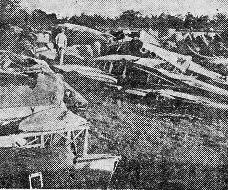 A G.I. prospects amid a plane salvage dump, which has been named "Moe's Junk Skop.".
A G.I. prospects amid a plane salvage dump, which has been named "Moe's Junk Skop.".
|
 A wing-clipped transport sits in a revetment waiting for new wings, motors and parts.
A wing-clipped transport sits in a revetment waiting for new wings, motors and parts.
|
American mechanical genius and drive don't allow planes to remain on the ground, even if parts are missing. Typical of USAAF fields of the CBI is this ATC base in eastern India, where plane cannibals have a field day every 24 hours. Cannibalization is the G.I. answer to planes that are grounded because of lack of essential replacement parts. In plain language, it means the stripping of one plane to put another craft into the air, saving the time and effort involved in transporting the wounded mechanical bireds back to repair depots in the rear. The motto of these G.I. miracle workers is "Get it back in the air." At times working 24 hours a day, it's the espirit de corps of these G.I. mechanics that keeps the sky full of American wings against the planes of Tojo over the CBI. (Photos by Bill Vandivert).
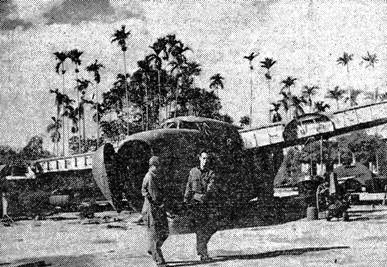 Two cannabilizers make off with a salvaged part from the abandoned cargo ship in the background, once a B-24
bomber, later a cargo carrier.
Two cannabilizers make off with a salvaged part from the abandoned cargo ship in the background, once a B-24
bomber, later a cargo carrier.
|
 S/Sgt. Everett Haggard pulls special screws from a scrapped wing in a salvage dump, which got its start where
two P-40's fell after a mid-air collision.
S/Sgt. Everett Haggard pulls special screws from a scrapped wing in a salvage dump, which got its start where
two P-40's fell after a mid-air collision.
|
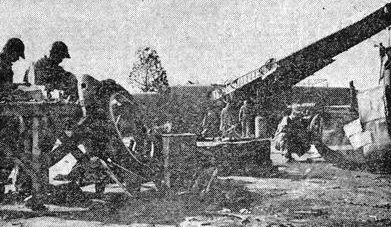 Mechanics demonstrate the efficiency with which a plane is cannabilized. Parts are sorted for future use to put
ailing ships back into service.
Mechanics demonstrate the efficiency with which a plane is cannabilized. Parts are sorted for future use to put
ailing ships back into service.
|
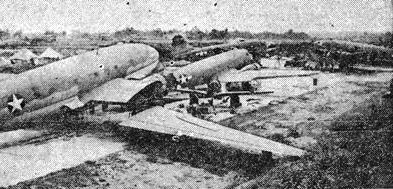 Four transports and a wee little P-40 fighter are worked on in a major overhaul revetment. Most fields handle
their own repairs if possible.
Four transports and a wee little P-40 fighter are worked on in a major overhaul revetment. Most fields handle
their own repairs if possible.
|
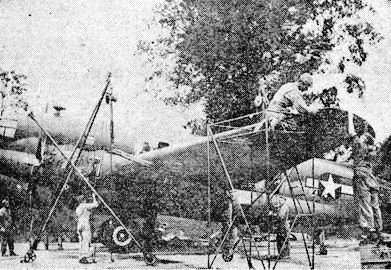 A wing "borrowed" from another "sick" plane is fitted to fuselage, putting another plane into the air that
would otherwise remain idle.
A wing "borrowed" from another "sick" plane is fitted to fuselage, putting another plane into the air that
would otherwise remain idle.
|
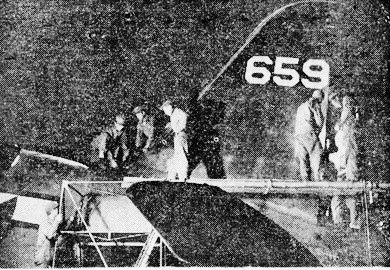 Under floodlights and an Indian moon, mechanics repair the tail of a huge transport. Maintenance and engineering
work goes on 24 hours a day.
Under floodlights and an Indian moon, mechanics repair the tail of a huge transport. Maintenance and engineering
work goes on 24 hours a day.
|
SURGEON PRAISES CHINESE COURAGE
NORTHERN BURMA - During his eight years of total warfare, countless soldiers have passed through the front line aid stations of Dr. Franz Kriegel. On the European and Asiatic Continents, this Prague university-educated Polish Jew has treated Spanish, French, British, Canadian, Rissian, Italian, American and Chinese soldiers and says the bravest and least complaining patients are the Chinese.
With the Spanish Loyalists, Kriegel held the rank of major, and in China, he represented the Chinese Red Cross. At the present time he is a contract surgeon, without rank, for Lt. Gen. Joseph W. Stilwell's Chinese-American forces.
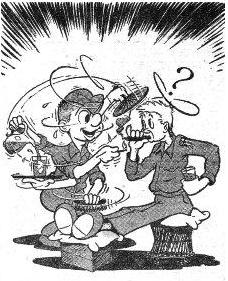
|
For three years Kriegel served with the Loyalists' 45th Division, but he says he frequently treated volunteers from other nations, including a number of Italian Fascist prisoners. When the Loyalist cause was lost, Kriegel caught a steamer at Marseilles and embarked for Hong Kong. Two weeks later he was treating the wounded of a Chinese division. During the three and a half years he was in China, he was the only European-educated doctor in the division and frequently the only one with the entire army. Often he was forced to oerate with meager medical supplies.
On Christmas of 1942, Kriegel transferred to India, where the Chinese were being trained by Americans, and organized and trained his medical staff. Most of the men on his staff, says Kriegel, "were simple peasant boys - illiterate, too - but they learned fast and have been extremely valuable." He is now one of 10 contract surgeons treating the Chinese in North Burma and is presently assigned with atank unit operating in the most forward aid station. Because of the numerous tank battles recently and the large number of casualties they bring, Kriegel is having his busiest season.
Col. Rothwell H. Brown, commander of the Chinese tank unit which was credited by Stilwell with slaying 500 Japs and capturing a record amount of booty in the Walawbum battle several weeks ago, told this correspondent of Kriegel's fine work in treating the wounded under fire. "I'm fortunate to have Doc Kriegel," said Brown, "He doesn't know the meaning of fear, and in the midst of the Walawbum fighting, he patched up between 40 and 50 wounded."
Thirty-six-year-old Kriegel, born in Stanislawow, studied at Prague University and then practiced medicine in Prague until he volunteered in the Spanish Civil War. He speaks eight languages, but not Chinese, despite the fact that the Chinese say he speaks "beautiful" Mandarin. Stockily built and barrel-chested, Kriegel is deeply browned from extensive outdoor living. He doesn't mind the jungle hardships, and his favorite topic of conversation is the courage of the Chinese soldiers, such as the tanker who charged four anti-tank guns, smashing the weapons and killing the crews, or the youth who, though badly wounded, insisted on telling everyone in the aid station that he had participated in a battle where two armored cars were captured.
"Chinese soldiers," said Kriegel, "are grand and brave. They're patient and appreciative, and when the wounded come in, they behave like men, even though most of them are only boys."
Nip Duds Fail To Halt Task Of Ledo 'Cats'
ALONG THE LEDO ROAD - Pfc. James R. Warren, of Philadelphia, a "cat" operator with an Engineer outfit, had himself an experience the other day that he'll never forget and which again emphasizes the pluck of the lads building the "Road to Tokyo,"
While clearing road trace through a section of the Hukawng Valley, from which Lt. Gen. Joseph W. Stilwell's Chinese troops ousted the Japanese, Warren maneuvered his bulldozer in the stygian darkness.
He backed up his spitting, roaring D-8, all prepared for another forward lunge, when suddenly the big blade in front of the machine kicked up about a foot and a half. This was accompanied by a dull explosion that covered him with a shower of wood and dirt.
A flashlight probed the darkness.
There, in front of the blade, lay the remnants of a large size calibre shell. Warren had kicked himself up a dud.
All through the night, Warren and his buddies on the night shift shoved ahead, clearing stumps, dirt and the rubble of the recently-fought battle. There were countless other duds in the area, each of them packed with lethal death - and they couldn't be seen.
But mere duds don't bother these boys. They've had too many other close brushes with death during the herculean task of building the Ledo Road.
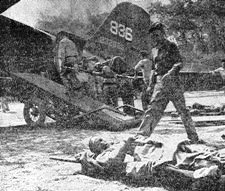 Orderlies from a field hospital load wounded Chinese soldiers into an airplane. In order to facilitate handling,
the ground crew has improvised a ramp from a trailer to add to the comfort of patients.
Orderlies from a field hospital load wounded Chinese soldiers into an airplane. In order to facilitate handling,
the ground crew has improvised a ramp from a trailer to add to the comfort of patients.
|
 Lts. Betty Pifer, Loudenville, O., and Esther M. Baer, Peoria, Ill., are part of an ambulance plane crew, in
the CBI Theater for four months.
Lts. Betty Pifer, Loudenville, O., and Esther M. Baer, Peoria, Ill., are part of an ambulance plane crew, in
the CBI Theater for four months.
|
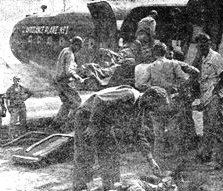 Chinese are assured of proper treatment and care if wounded in the bitter fighting taking place in the Mogaung
Valley. Injured are airplaned back to well-equipped hospitals.
Chinese are assured of proper treatment and care if wounded in the bitter fighting taking place in the Mogaung
Valley. Injured are airplaned back to well-equipped hospitals.
|
Jap Aerial Raid Costly As 14th Shatters Zeros
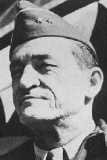
|
14th A.F. HQ. - After a comparitive lull for several weeks, the 14th Air Force reared up on its haunches and gave Japanese air and shipping power, plain, unmitigated Hell.
In the most devastating attack of the past week, fighter pilots downed nine Zeros, probably destroyed three and damaged three in a running fight with 32 enemy planes, which attacked Allied airfields at Nanning on April 5. Nanning is in the southwestern Kiangsi Province, 75 miles north of the Indo-China border.
One American aircraft was lost in a mid-air crash with a Zero, one other was destroyed on the ground and a third was damaged. Only slight damage was done to the airfield. At the same time, bombers attacked the railroad siding at Nacham in French Indo-China. Two direct hits destroyed eight railroad cars and tore up considerable trackage.
HAINAN ISLAND HIT
Several days later, Mitchell bombers, on a sea sweep off the southern coast of Hainan Island, attacked and destroyed a 1,200-ton tanker. On the way back from this mission, Gen. Claire Chennault's bombers were intercepted by seven Tojo-type Jap fighters, which were operating with an undetermined number of other fighters as a top cover. Four of the enemy were destroyed and three were probably destroyed. B-24's, on the night of April 8, bombed the docks and airdrome at Smah Bay, also on Hainan Island, with unobserved results. All aircraft returned safely.
During the same night, Mitchells attacked the airdrome at Weichow Tao in the Tong King Gulf. The control tower, radio station and barracks area were damaged. Other Mitchells on a mission to Yulikan Bay on the southern tip of Hainan Island, caused slight damage to a 1,000-ton freighter and attacked a number of smaller vessels, several of which were left burning. The bombers were intercepted by 11 Jap fighters, two of which were destroyed and one damaged.
OIL DUMP BOMBED
During daylight, Liberators struck at the rail yards at Hanoi, French Indo-China. P-40's bombed and strafed Jap installations at Wenling, on the Yunnan-Burma border. Hits were observed on an oil dump, which caught fire.
Mitchells, on April 7, during a sea sweep of the Tong King Gulf attacked and slightly damaged two 1,200-ton enemy freighters. The flight was intercepted by four Japanese fighters, one of which was probably destroyed and one damaged. Meanwhile, Liberators on a sea sweep of the South China Sea, bombed and probably sank a 1,100-ton freighter. Other Liberators probably sank two vessels off the southern tip of Hainan Island.
The day before, Mitchells attacked the Tien Ho and White Cloud airdromes near Canton and fighter-bombers hit the barracks area southwest of of Nanchang, in Central China. From this mission three American craft failed to return.
Meantime, Liberators, with a fighter-bomber escort, poured 23 tons of demolition and incendiary bombs on Kiungshan airdrome, on Hainan Island. Direct hits were scored on three hangars, the control tower, six barracks buildings and seven repair shops. Two or more enemy aircraft were destroyed on the ground.
Commandos Hit Japanese Field, Claim 25 Planes
The Eastern Air Command, having taken the Japanese Air Force apart in the air last week, started this week by giving it a going over on the ground. Col. Philip Cochran's American Air Commando Force, in a sudden sweep on Aungban Airfield the morning of April 4, knocked off 25 Jap planes, probably destroyed two more, and damaged eight. On the way home, they destroyed a twenty-sixth at Anisakan.
In a raid on the same place the same morning, U.S. Lightnings of Sir John Baldwin's Tactical Air Force destroyed seven and probably destroyed four more. Just the previous evening, R.A.F. night-fighters, operating over Northwest Burma, destroyed two in the air.
The Commandos needed but six minutes to make a mess of Aungban. Aside from the damage to planes, they shattered two anti-aircraft positions and started numerous fires. Other Tactical Air Force planes, covering the field the next day, reported it almost completely burned out.
HEAVIES HIT BRIDGES
On April 5, Maj. Gen. Howard C. Davidson's Strategic Air Force took its second sweep at the Burma-Siam railroad within a month. U.S. heavies, attacking from low level, destroyed three bridges, probably destroyed five more,
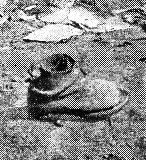 This solitary shoe from a Jap soldier was found lying in a recently occupied enemy position by American Army
Engineers who are pushing the Ledo Road toward China. Significantly enough it is pointed in the direction of
the Jap retreat before Lt. Gen. Joseph W. Stilwell's Chinese-American forces.
This solitary shoe from a Jap soldier was found lying in a recently occupied enemy position by American Army
Engineers who are pushing the Ledo Road toward China. Significantly enough it is pointed in the direction of
the Jap retreat before Lt. Gen. Joseph W. Stilwell's Chinese-American forces.
|
In a daring daylight attack, R.A.F. long-range fighters of the Tactical Air Force hit Siam again three days later, blasting Chiengmal Railway Station and destroying large numbers of river craft, two oil barges, and an enemy plane which was unfortunate enough to get in the way. Throughout the week the R.A.F. units also maintained their attacks on communications throughout Southern Burma.
COMMUNICATIONS SUFFER
The Commandos also were rough on communications. In an attack on Ywataung Junction on April 9, they damaged five more locomotives and left 60 rolling stock burning. Trucks loaded with troops were shot up and there were many casulaties. a paddle steamer was burned, and a large gasoline dump south of Indaw left in flames.
It was a hard week on bridges too. The Meza Bridge was badly damaged on April 4, and, on the 10th, U.S. mediums knocked one span of the Sinthe Bridge into the river and damaged trackage on other spans. The same day they knocked the north end of the Thityabin Bridge out of line.
Throughout the period, in support of ground troops, R.A.F, I.A.F and USAAF tactical and strategic units cooperated in beating up troop concentrations, lines of supply and stores and dump areas throughout the Arakan, Mayu, Chin Hills, Chindwin and Kaladan areas and throughout Northern Burma. Southern Burma also took a steady beating, with the Rangoon and Moulmein areas being especially hard hit, while Mandalay was the center of repeated battering at Japanese strongholds in Central Burma.
|
STORK TIP CANCELS MARTHA'S TRIP
All that stood between actress Martha Raye and her proposed entertainment tour of the CBI Theater was a baby, it was revealed this week. Miss Raye disclosed the fact that she and her fourth husband, dancer Nick Condos, are infanticipating sometime next fall. She was planning a tour to CBI-land "when I found out." |
|
Underground
CHINESE ESCAPE
Reports reaching Roundup this week from Army News Service told the dramatic story on an Underground Railway, patterned after that of the Civil War slave era, which has aided the escape of 400 skilled technicians from Japanese-occupied China. Revelation was made by Irving Abramson, chairman of the CIO War Relief Committee, who stated that the project, which has been in operation since last September, is financed partly by CIO and AFL war relief funds. |
PICK SEEKING INSIGNIA FOR LEDO ROADSTERS
LEDO ROAD - Along the Ledo Road this week, Brig. Gen. Lewis A. Pick has approved a sketching contest to discover a design for a Ledo Road insignia.
The contest is open to all who have taken part in the building of this project. The reward will be a two-week furlough.
The new insignia will symbolize such deeds as that of T/5 Albert Allen, who was posthumously awarded the Soldier's Medal, after attempting to rescue Pfc. Herbert Simms from a swollen stream. Allen died in the attempt and was carried to his death with the comrade he had sought to rescue. A bridge has been named in his honor.
Colored troops, whose aching backs have contributed many a mile to the Road, saw colored line officers here for the first time in two years. Several recently arrived with a Quartermaster outfit, including Chaplain G. H. White, of Lauren, S.C.
One unit of colored troops decided to celebrate the arrival of the officers with a steak dinner. Steak has been unknown on the Road for a long time, but the G.I.'s went out on a hunting expedition and bagged four wild buffaloes.
The steaks were broiled to the nth degree and served with mashed potatoes and string beans. But - the onion supply had run out the day before.
‘Mayor’ of India Village
PFC. BRIDGES DIPLOMATIC GAP
MEDIUM BOMBER SQUADRON - Erudite, soft-spoken Pfc. Ralph R. Hansen, the unofficial mayor of Alotimruk village, is proving one of the Skull and Wings Squadron's foremost goodwill emmisaries among the citizens of the vicinity. His has been one of the most successful efforts yet to bridge the proverbial gap between East and West.
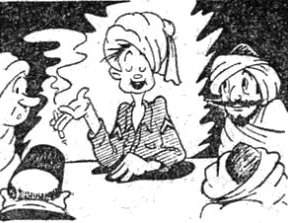
|
A sincere student of polyglot India, Hansen can be found almost any evening in one of the village teashops, painting a graphic picture of America and otherwise chatting amicably in his hybrid of English and Hindustani with his many Indian friends. Although he has not (yet) adopted the dhoti, he has gone considerably native in dress.
SITS IN ON COUNCIL MEETINGS
Known to practically the entire village population as a good friend, he sometimes sits in on village council meetings at the request of the mayor, frequently offering suggestions in an effort to solve some pressing municipal problem such as disposal of the dead, the "high price of khanna" and others. His interest is more than superficial.
In many ways a fatalist, he expresses a genuine liking for Indian foods. Dinner invitations are frequent and Hansen, although not a gourmet, can attack his rice bowl with unfeigned gusto.
A secretary in civilian life, to our hero sometimes falls the task of righting some Indian-felt wrong caused by thoughtless G.I.'s who might have staggered a bit out of line on a night of inebriation. Because he is held in high esteem, Hansen can usually make himself heard. He has not yet failed to diplomatically smooth troubled waters.
OFFERS OF MARRIAGE ADVANCED
This might interest you guys who've been here so long you're beginning to think of taking out citizenship papers. The love interest. Hansen has received several roundabout offers of marriage from match-making fathers of some of the village's most attractive and eligible maidens . . . but there he draws the line with a firm, "Nay, sahib!" He realizes all too well that discretion here, as in few other situations, is decidely the better part of valor. "I may have gone native," he explains, "but not that much."
G.I.'s often question him regarding the possibility of his evening candidacy for village mayor. His terse, Coolidge-like reply: "I do not choose to run. I'd rather remain the man behind the scenes."
LIFE PUBLISHES ARTICLES ON CBI
Life this week published two features from the CBI Theater.
First of these is Elephants at War by Phillip Wynter. It tell's about "Elephant Bill," whose elephants are "light cranes and mobile winches of front-line screen troops just across the central part of the India-Burma frontier."
Described are the work of the "Uzies," who drive the elephants, carrying of food and ammunition to small bodies of troops sitting on a rocky crag who might otherwise be almost cut off from supplies, and letters asking whether elephants could be taught to suck up tar and squirt it on roads and whether they could be trained to crank stalled cars.
The second is War In Burma , pictorially illustrated by Bill Vandivert, with pictures of Lt. Gen. Joseph W. Stilwell, dead Japs and Col. Rothwell H. Brown, commander of the Chinese tank detachment.
|
SMITH DREAMS . . DEEP IN HEART OF CHINA
LETTER FROM UNKNOWN LEADS TO REGULAR SUGAR REPORTS
CHINA BOMBER BASE -This is a short, short story - in a few letters.
Lt. Gerald T. Smith opened a letter forwarded to him from the Kansas base where he had trained. It was a sugar report from an Army nurse stationed in Washington.
Smith didn't know the sender, but what he had seen of this effort convinced him he should make her acquaintance. So he penned an epistle explaining the mistake and asked her to write.
She replied that the Lt. Smith for whom the letter had been written had gone to England. She said she would be glad to correspond regularly. One of her letters enclosed a snapshot which Smith says ranks his friend as worthy of top spot in his pin-up collection.
She also wrote that the Smith who had gone to England had since became engaged to another girl. So she writes no more sugar reports to the Britain-based Smith.
The end of the story depends on the rotation plan and how it affects the China member of the Smith tribe.
INDIANS TAUGHT ARMY SYSTEM
WEST INDIA ASC BASE - Sgt. Warren Kinlaw has introduced the American Army discipline and promotion system to the Indians under his command in the Transportation section.
Kinlaw has awarded paper stripes to his Indian hirelings who show the best straw boss qualities. The sergeant also breaks his men for inefficiency, and to follow the G.I. trend thoroughly last week he broke a man to a private and then made him a non-com again after he had demonstrated outstanding efficiency.
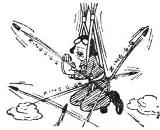
|
'CHUTIST TARGET FOR GROUND FIRE
By SGT. SMITH DAWLESS
ASSAM - Butterflies did nip-ups in an American pilot's stomach.
Bullets "zinged" uncomfortably around him like angry bees. Which wasn't good, for he was floating lazily earthward by parachute, having been forced to jump from his plane.
By some miracle of misdirection, the bullets missed him, however. And when, after what seemed hours of dangling in air in the role of a clay pigeon, he hit the ground, the pilot scrammed into the jungle overgrowth jaldi.
He tried to recall what the pamphlets advised about survival in the jungle. Should he head upstream or down? What kind of forests offered the best refuge?
After a futile struggle with his memory, he stuck his head out and read a sign, "Slow."
Were the Japs using English?
Hope flickered . . . and, with it, a determined voice rang out some 20 feet away:
"If you is an American soldier, come out. If you is a Jap paratrooper, stay where you are on account of I got you covered."
"I am," replied the pilot with a pardonable flutter of relief in his voice, "an American, and here I come."

With each Thursday's edition I keep hoping for one omission. With fingers crossed and eager eye With an expression of "never-say-die," I hurriedly turn to the Poet's Corner; And sure enough, like Little Jack Horner, There's a verse or poem, however flawless, But always written by Sgt. Smith Dawless. By S/Sgt. ARTHUR D. SHERMAN |
|
The Chaplain speaks to soldiers as a friend What if there be no building set apart For worship only? At the world's far end There is no other altar than the heart Perhaps our man-made temples are too small Without a divine or spire arising there A synogogue is built but has no wall A vast cathedral fills the open air The soldiers hymn in reverence off-key Recalling hometown choice, they lift loud praise It may be in a closer harmony Than congregations knew in carefree days He offers benediction on the farms The factories and homes and loved ones there Above bowed heads, he stretches forth his arms While khaki-covered hearts commune in prayer If he revives that dream wherein men saw A better world to be, it will suffice Whether he wears the tablets of the law Or else the silver cross of sacrifice. By Sgt. G. ELWOOD JONES |
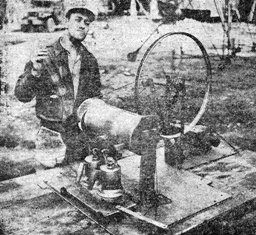 This is the rare and wonderful peanut roaster invented by M/Sgt. Lewis (Buck) Roberts, who has applied certain
Rube Goldbergian ideas in its construction. Parts have all come off wrecked craft of one kind or another. Twenty
to thirty minutes is the roasting time.
This is the rare and wonderful peanut roaster invented by M/Sgt. Lewis (Buck) Roberts, who has applied certain
Rube Goldbergian ideas in its construction. Parts have all come off wrecked craft of one kind or another. Twenty
to thirty minutes is the roasting time.
|
New Troupe Of Entertainers Touring Ledo Road Area
LEDO ROAD - New touring hit of the Ledo Road entertainment world is Who's In Charge Here?. Directed by S/Sgt. Paul Krauss, who also acts as emcee, this production features music and comedy.
The feature skit has Pvt. John Schoepperie, who plays Eleanor to Pvt. John Grant's Franklin D. Other principals are Lt. Helen Schropp, ANC, and Cpl. Paul Hart, who duet in Me and My Gal; Pvt. Ronald Blain, Sgt. Stanley Evans, Sgt. Paul Gonzales, Sgt. Dave Tamburri, S/Sgt. Joe Menta and the piano team of Cpl. Boatwright and Cpl. Carey.
Word has come from China about a band formed by Lt. Addies Bailey, former pianist at Leon and Eddie's in New York. Bailey now has a 14-piece outfit with a sax player from Jack Teagarten and a trumpeter from Al Donohue.
One of their most important numbers is the Chinese National Anthem, since Chinese soldiers and girls make up a good part of every audience.
G.I. REMBRANDT PAINTING PICTURES ALONG LEDO ROAD
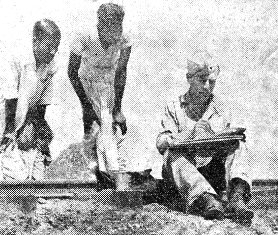
|
He can be found most days painting the Indian countryside somewhere in the vicinity of the Ledo Road.
He's generally surrounded by a curious crowd, made up of Indians, Chinese and American troops.
Hall, a native of New York, has saved the sketches he has made in India and hopes to take them home after the war to decorate his flat on Tremont Ave. in the Bronx.
"I used to be a marble worker before the war. Sometimes I fooled around with marble carving, but I liked painting best."
Hall finds India a contrast to his home state. But he prefers the sketches he made along what promises to be the historically-famous Ledo Road to the ones he made on the Storm King Highway in the Hudson Valley.
The CBI Roundup is a weekly newspaper of the United States Army Forces, published by and for the men in China, Burma, and India, from news and pictures supplied by staff members, soldier correspondents, the United Press, OWI and the Army News Service. The Roundup is published Thursday of each week and is printed by The Statesman in New Delhi, India. Editorial matter should be sent directly to Capt. Floyd Walter, Headquarters., U.S.A.F., C.B.I., New Delhi, and should arrive not later than Sunday in order to make that week's issue. Pictures must arrive by Saturday and must be negatives or enlargements. Stories should contain full name and organization of sender.

APRIL 13, 1944
Original issue of C.B.I. Roundup shared by Virginia Dyer, widow of CBI veteran Stanley Dyer.
Copyright © 2006 Carl Warren Weidenburner
ELEPHANTS AT WAR BURMA WAR
TOP OF PAGE PRINT THIS PAGE ABOUT THIS PAGE SEND COMMENTS
PREVIOUS ISSUE CLOSE THIS WINDOW NEXT ISSUE
